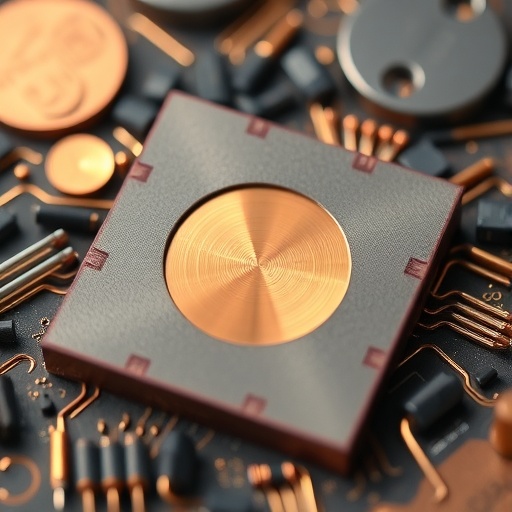In an exciting development within the realm of analytical chemistry, researchers have unveiled a groundbreaking method for the ultrasensitive electrochemical detection of trace copper. The innovative approach employs a composite material that combines Iron Oxide with expanded graphite, significantly enhancing the material’s ability to detect low concentrations of copper ions in various environments. This advancement is particularly relevant in fields like environmental monitoring, where tracing heavy metal pollutants is crucial for maintaining ecosystem health.
Copper, while essential in small quantities for biological functions, becomes harmful at elevated levels. Its presence can lead to severe environmental and health issues, making the ability to detect trace amounts imperative. The new detection method promises not only to identify copper at unprecedented sensitivity levels but also to offer practicality and efficiency in real-world applications. By utilizing a combination of iron oxide and expanded graphite, the researchers have created a material that excels in conductivity and electrochemical performance.
The research team, led by S. Paramparambath, along with M.S. Sha and M.A. Khan, has meticulously demonstrated the efficacy of this new detection method. Their findings suggest that the hybrid material not only amplifies the electrochemical signals associated with copper ions but also exhibits remarkable stability over time, making it suitable for prolonged use in diverse scenarios. This long-term stability addresses a common challenge faced in electrochemical sensors, where sensitivity often diminishes after repeated exposure to target analytes.
Upon testing, the detection limits achieved with the iron oxide-expanded graphite composite were astoundingly low, thereby revealing its potential for application in instances where conventional methods fall short. For example, in the monitoring of drinking water or agricultural runoff, detecting even minute concentrations of copper can have significant public health implications. Therefore, the advancements summarized in this study represent not just a technical achievement but a crucial stride toward ensuring safer environmental practices.
Moreover, the researchers explored the operational parameters of their new electrochemical sensor. They thoroughly examined various influencing factors such as pH levels, temperature, and ionic strength, which are critical for the nuanced behavior of electrochemical reactions. These insights are fundamental for optimizing the sensor’s performance, allowing real-time adjustments in various environmental monitoring scenarios.
Additionally, the electrochemical properties of the iron oxide-expanded graphite composite were characterized through cyclic voltammetry and differential pulse voltammetry. These methods provided a comprehensive understanding of the electrochemical kinetics involved, further establishing the reliability and effectiveness of the sensor. The results not only highlight the material’s remarkable sensitivity but also its promise as a viable alternative to traditional spectroscopic methods, which often demand extensive sample preparation and more complex equipment.
Implications of this research extend beyond environmental monitoring. The technology could be pivotal in sectors like food safety, where trace copper levels can affect product quality and consumer health. For instance, in agricultural contexts, where copper-based fungicides are often used, accurate monitoring of copper content in soils and produce could help mitigate health risks associated with ingestion of heavy metals.
Furthermore, the authors of the study accentuate the importance of such innovations, noting that facilitating easier access to reliable detection methods could boost public awareness regarding environmental contaminants. Raising awareness about the impacts of copper pollution could lead to more sustainable practices among both industries and consumers.
The comprehensive testing of this composite material also opens avenues for further research. By altering the ratios of iron oxide to expanded graphite or experimenting with other composite materials, researchers may find ways to enhance sensitivity even further. The study encourages further exploration into versatile applications, urging other scientists to build upon their work, potentially leading to even greater breakthroughs in the field of electrochemical sensors.
Through rigorous experimentation and analysis, the team has established a robust foundation for future studies, not only reinforcing the current findings but also illustrating the pathway for developing next-generation sensing technologies. As public and scientific interest grows, the push for more sensitive, cost-effective, and user-friendly detection methods becomes crucial.
In conclusion, the findings reported by Paramparambath and colleagues mark a significant advancement in electrochemical detection technologies. The ability to detect trace copper levels with unprecedented sensitivity has wide-ranging implications for environmental monitoring, food safety, and public health, laying the groundwork for future innovations in various fields. As researchers continue to refine and improve these technologies, we can anticipate a substantial impact on how we monitor and manage heavy metals in our environment.
This groundbreaking research highlights the dynamic intersection of chemistry, environmental science, and technology. The implications are vast, with the potential to transform current practices surrounding copper detection, ultimately serving as a model for future technological advancements in the detection of other heavy metals. As the world moves towards greater transparency and safer practices, studies such as these reaffirm the invaluable role of scientific inquiry in addressing global challenges.
Subject of Research: Electrochemical detection of trace copper using iron oxide—expanded graphite.
Article Title: Ultrasensitive electrochemical detection of trace copper using iron oxide—expanded graphite and its applications.
Article References:
Paramparambath, S., Sha, M.S., Khan, M.A. et al. Ultrasensitive electrochemical detection of trace copper using iron oxide—expanded graphite and its applications.
Ionics (2025). https://doi.org/10.1007/s11581-025-06688-1
Image Credits: AI Generated
DOI: https://doi.org/10.1007/s11581-025-06688-1
Keywords: Ultrasensitive detection, Electrochemical sensor, Trace copper, Iron oxide, Expanded graphite, Environmental monitoring, Public health, Food safety, Heavy metals.
Tags: advanced analytical chemistryconductivity and electrochemical performancecopper ion detection stabilityelectrochemical detection methodsenvironmental monitoring techniquesheavy metal pollutant detectionhybrid material developmentiron oxide-graphite sensorsPractical Applications in Environmental Scienceresearch on heavy metal toxicitytrace copper analysisultrasensitive copper detection





